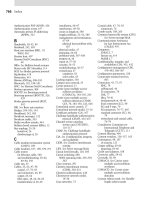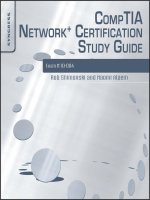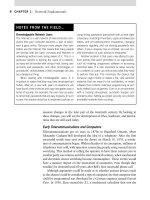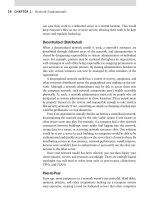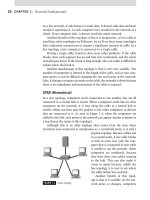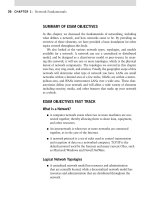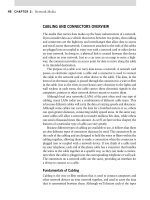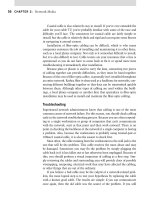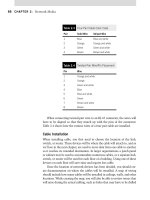CompTIA Network+ Certification Study Guide part 77 docx
Bạn đang xem bản rút gọn của tài liệu. Xem và tải ngay bản đầy đủ của tài liệu tại đây (249.29 KB, 10 trang )
Appendix C
746
Over the weekend you have installed a new NIC in a server and 15.
have configured the NIC to have the same static IP address that
was set on the old NIC. First thing Monday morning you receive a
network alert that there is large number of broadcasts taking place
on the network segment where this server resides. What is the
probable cause for the increase in broadcasts?
A. ARP resolutions
B. RARP resolutions
C. DNS resolutions
D. Dig attempts
Correct answers and explanations: A. Answer A is correct because by
replacing the NIC in the server, the IP address to MAC address information
that was cached on other machines for that server is now out of date. In
order to communicate with the server successfully the other machines will
perform an ARP broadcast requesting the MAC address that corresponds to
the server’s IP address. Since the replacement took place over the weekend
when it was likely that many machines were off or not in use, the spike in
broadcasts was not seen until Monday morning when the machines were
powered on and attempting connection to the server. The ARP broadcasting
will subside once resolution has occurred and the machines are able to store
the new MAC and IP address values in their ARP cache.
Incorrect answers and explanations: B, C, and D. Answer B is incorrect because
RARP is reverse ARP and in this case it is unlikely that it is being required to
connect. The name and the IP address of the server did not change, so DNS and
other name resolution systems would have the correct information. So once
the name resolution has taken place to provide an IP address, the final compo-
nent to retrieve is the MAC address that corresponds to the IP address. ARP is
responsible for mapping IP addresses to MAC addresses, not RARP. RARP maps
MAC addresses to IP addresses. Answer C is incorrect because DNS resolution
does not occur over a broadcast. DNS resolution is directed traffic sent to the
DNS server. Answer D is incorrect because Dig attempts do not occur over a
broadcast. Dig is traffic that is sent directly to the DNS server.
ChApTEr 12: NETworK TrouBlEShooTING
METhodoloGy
You are a network consultant specializing in supporting Small 1.
Office Home Office (SOHO) networks. One of your clients
maintains an office consisting of three workstations configured
Appendix C 747
in a peer-to-peer workgroup. This office does not have a server
computer at this time. One of the workstations, \\OFFICE1, has
an IP address of 192.168.1.100 and has a file share that the other
three workstations are able to access using the following syntax:
\\OFFICE1\share. Your client has called you in to troubleshoot a
new workstation that they have recently installed that is unable
to access this share. When you arrive on site, you find that the
workstation is able to ping OFFICE1 by its IP address, but not by
its NetBIOS name. What is the best way for you to allow the new
workstation to access the file share located on OFFICE1?
A. Upgrade OFFICE1 to Windows 2003 server and configure the
WINS Server service.
B. Add an entry to the lmhosts file on the new workstation.
C. Add an entry to the findhosts file on the new workstation.
D. Upgrade OFFICE1 to Windows 2003 server and configure the
DNS service.
Correct answers and explanations: B. Answer B is correct, because a
Universal Naming Convention (UNC) path is being used to attempt to
connect to the OFFICE1 machine. UNC paths utilize NetBIOS names for
connectivity, so the NetBIOS name of OFFICE1 must be resolved to an IP
address before a connection can be successful. The LMHOSTS files is a local
text-based file which is used to resolve NetBIOS names. By adding an entry
into the LMHOSTS file for the OFFICE1 machine, the new workstation will
be able to resolve the name, get an IP address, and then use the IP address to
make a successful connection to the share.
Incorrect answers and explanations: A, C, and D. Answer A is incorrect,
because upgrading a workstation operating system to a server operating sys-
tem is not a viable upgrade path for Windows-based systems. If a fresh install
of Windows 2003 was to be performed, and WINS were to be installed, then
all of the machines in the office would need to be configured to utilize WINS.
In a small office setting with so few machines, installing a server-based sys-
tem and a name resolution service like WINS is possible, but it is much
more than such a small setting requires. Answer C is incorrect, because the
findhosts file doesn’t exist. It is a fictional file name. Answer D is incorrect,
because DNS is a service that is used for host names, and not for NetBIOS
name resolution. Also, upgrading a workstation operating system to a server
operating system is not a viable upgrade path for Windows-based systems. If
a fresh install of Windows 2003 was to be performed, and DNS were to be
installed, then all of the machines in the office would need to be configured
Appendix C
748
to utilize DNS. In a small office setting with so few machines, installing a
server-based system and a name resolution service like DNS is possible, but
it is much more than such a small setting requires.
You are troubleshooting network connectivity issues on a network 2.
that is running Windows servers and clients. Users are reporting
that they are unable to send e-mail, though they have been receiv-
ing messages from external users without a problem. During your
troubleshooting, you see the configuration item on the Windows
server that is shown in Figure 12.8. Based on this information, how
can you correct the issue that this office is reporting?
A. Install and configure the POP3 service.
B. Change the startup type of the SNMP Trap Service to Automatic.
C. Start the Simple Mail Transport Protocol (SMTP) service.
D. Start the Routing and Remote Access Service.
Correct answers and explanations: C. Answer C is correct, because the
Simple Mail Transport Protocol (SMTP) service is utilized to send e-mail.
On this server the service is in a stopped state, even though it is configured
to start automatically. While the service is stopped e-mail cannot flow out-
bound from the system and users will not be able to send mail until the
service is restored to a Started state.
FIGurE 12.8
Appendix C 749
Incorrect answers and explanations: A, B, and D. Answer A is incorrect,
because POP3 is a protocol used to receive mail. This question states that
users are receiving mail without an issue, and it is the sending of e-mail that
is not functioning. Answer B is incorrect, because SNMP is an acronym for
Simple Network Management Protocol. It is a protocol used to manage and
collect information about a network infrastructure and it is not used for
e-mail sending purposes. Answer D is incorrect, because the Routing and
Remote Access Service (RRAS) is utilized to validate remote access sessions.
It is not used in to send e-mail messages and therefore is not the appropriate
solution to the issue presented.
You are a network consultant and have been called in to trouble-3.
shoot a connectivity issue on a UNIX network. From the client’s
UNIX workstations, which of the following utilities can you use to
perform network troubleshooting? (Select all that apply.)
A. Ping
B. Tracert
C. Pathping
D. Traceroute
E. Nslookup
F. Dig
Correct answers and explanations: A, D, E and F. Answer A is correct,
because ping is a command that can be utilized on a UNIX-based worksta-
tion in order to troubleshoot TCP/IP connectivity problems. Answer D is
correct, because traceroute is a command that can be utilized on a UNIX-
based workstation in order to troubleshoot routing-related issues that may
exist. Answer F is correct, because dig is a command that can be utilized
on a UNIX-based workstation in order to troubleshoot DNS-related issues.
Answer E is correct, because nslookup is a command that can be utilized to
troubleshoot DNS from a Windows or a UNIX-based system.
Incorrect answers and explanations: B and C. Answer B is incorrect, because
tracert is a command that is used to troubleshoot routing-based issues from a
Windows-based system. Answer C is incorrect, because pathping is a command
also used to troubleshoot routing-based issues from a Windows-based system.
You are the network administrator for a network that employs a 4.
Windows 2003 server and 30 Windows XP Professional worksta-
tions. The Windows 2003 server runs the DHCP service to provide
TCP/IP configuration information to the Windows XP clients. You
receive a call from one of your users stating that he is unable to
Appendix C
750
browse any internal network resources or Internet websites. Other
users on the same subnet are able to browse without difficulty. You
run the ipconfig command on the problem workstation and see the
following output:
Windows IP Configuration
Host Name: IBM-A38375FF22E
Primary Dns Suffix:
Node Type: Hybrid
IP Routing Enabled: No
WINS Proxy Enabled: No
Ethernet adapter Wireless Network Connection:
Connection-specific DNS Suffix:
Description: Intel(R) PRO/Wireless 2200BG Network Connection
Physical Address: 00-1E-25-1A-D3-5A
Dhcp Enabled: Yes
Autoconfiguration Enabled: Yes
IP Address: 169.254.1.96
Subnet Mask: 255.255.0.0
Default Gateway:
DHCP Server:
DNS Servers:
Lease Obtained: Tuesday, March 29, 2005 1:00:10 PM
Lease Expires: Wednesday, March 30, 2005 1:00:10 PM
Based on this output, why is this workstation unable to browse any
network resources?
A. The default gateway is unavailable.
B. The workstation could not contact a DHCP server.
C. The workstation is configured with the incorrect default gateway.
D. The workstation’s DHCP lease has expired.
Correct answers and explanations: B. Answer B is correct, because the
workstation is displaying a 169.254.1.96 IP address, which is an APIPA
address. APIPA is short for Automatic Private IP Address and covers a range
of 169.254.0.0 through 169.254.255.254. An address from this range is
automatically assigned to a machine when it is configured to utilize DHCP,
but it is not able to contact a DHCP server. Typically when a machine is
assigned an APIPA address it is not able to connect to with the rest of the
network, since the rest of the network will most likely be utilizing a differ-
ent addressing scheme. In very small business networks and home network
environment is it possible to rely on APIPA for addressing. APIPA does not
Appendix C 751
configure variables such as a gateway, so in most corporate environments
where routers exist, APIPA isn’t appropriate for network configurations.
Incorrect answers and explanations: A, C, and D. Answer A is incorrect,
because a default gateway is never configured when an APIPA address has
been assigned. Answer C is incorrect, because the workstation does not have
a gateway value configured; it has an APIPA address configured, which never
has an accompanying gateway value. Answer D is incorrect, because when
a workstation’s DHCP lease has expired it will attempt to renew its existing
IP address. It is only is if is unsuccessful in renewal that it will be forced to
abandon the currently issued IP address. It will then issue an APIPA address
instead.
You are the network administrator for a sales office. Until now, this 5.
has been a small peer-to-peer network consisting of five Windows
XP workstations using lmhosts files on each workstation to per-
form name resolution. The sales force has recently expanded sig-
nificantly, requiring you to purchase a Windows Server 2003 server
and 15 additional workstations. You have encountered numerous
troubleshooting situations where a workstation’s lmhosts file was
missing or out of date, preventing name resolution from taking
place. How can you improve the name resolution process for your
network?
A. Install the DNS service on the Windows 2003 server.
B. Install the WINS service on the Windows 2003 server.
C. Install the DHCP service on the Windows 2003 server.
D. Install the DNS service on each Windows XP workstation.
Correct answers and explanations: B. Answer B is correct, because by
centralizing the name resolution service by deploying WINS, much of the
maintenance and overhead that comes with managing a distributed name
solution is removed. Since once a workstation is configured to use WINS
they will automatically update and register their name and IP informa-
tion, the burden is taken off the administrator to keep the local text-based
LMHOSTS file up to date.
Incorrect answers and explanations: A, C, and D. Answer A is incorrect,
because DNS services are utilized for hostname resolution, and this scenario is
utilizing lmhosts files, which are used for NetBIOS name resolution. Answer C
is incorrect, because DHCP is a service utilized to configure IP addresses, and
not a service used to aid in name resolution. Answer D is incorrect, because
DNS is a service that is installed on server-based platforms, and not on
Appendix C
752
workstation machines. For local hostname resolution on a workstation, a host’s
file may be used.
You are the network administrator for a large pharmaceutical com-6.
pany that has over 1,000 workstations. To simplify TCP/IP configu-
ration for these numerous clients, you installed a DHCP server over
a year ago to automatically configure your clients with an IP ad-
dress, as well as the following common configuration information:
Subnet Mask: 255.255.0.0
Default Gateway: 172.16.0.1
DNS Servers: 172.16.0.100
172.16.0.101
As part of a recent network redesign, you had to change the default gate-
way used by your clients to a different IP address: 172.16.1.1. You made
the necessary change on the DHCP server, and most of your clients were
updated automatically. After you make this change, you receive a call
from one user who no longer is able to browse the Internet. You examine
the TCP/IP configuration of her LAN connection (see Figure 12.9).
How can you configure this workstation with the correct default gate-
way information? (Each choice represents a complete solution. Choose
two.)
A. Delete the manually configured information and select Obtain
an IP address automatically.
B. Run ipconfig /renew from the command prompt.
C. Manually update the IP address of the default gateway.
D. Run ipconfig /release from the command prompt.
Correct answers and explanations: A and C. Answer A is correct, because
by changing the configuration to Obtain an IP address automatically the
machine will connect to the DHCP server to receive an IP address and also
receive the configured options which include the new default gateway value.
Answer C is correct, because by manually updating the IP address of the
default gateway on the client machine it will be able to connect to the correct
default gateway.
Incorrect answers and explanations: B and D. Answer B is incorrect,
because an ipconfig/renew command will force a client to attempt renewal
of its DHCP address. Since this client machine is configured with a static
IP address, issuing this command will not have an effect, and will not cause
the client machine to receive the correct default gateway from the DHCP
server. Answer D is incorrect, because ipconfig/release command will force
Appendix C 753
a client to release its current DHCP address. Since this client machine is
configured with a static IP address, issuing this command will not have an
effect, and will not cause the client machine release a DHCP address since
it doesn’t have one. Also, since it is configured with a static IP address this
command will not cause the client to receive the correct default gateway
from the DHCP server.
You are the administrator for the network shown in the Figure 7.
12.10. Based on the information in this figure, which computer is
configured incorrectly?
A. Computer1
B. Computer2
C. Computer3
D. Computer4
E. Computer5
FIGurE 12.9
Appendix C
754
F. Computer6
G. Computer7
H. Computer8
Correct answers and explanations: D. Answer D is correct, because
Computer4 has an incorrectly configured IP address. The machine is
connected to a segment with the network address of 192.168.4.0/24, yet
Computer4 has an IP address of 192.168.5.101/24. This will prevent the
machine from properly connecting to its default gateway and any other
nodes on the same segment.
Incorrect answers and explanations: A, B, C, E, F, G, and H. Answer A
is incorrect, because Computer1 has a correctly configured IP address.
The machine is connected to a segment with the network address of
192.168.3.0/24, and Computer1 has an IP address of 192.168.3.101/24.
Answer B is incorrect, because Computer2 has a correctly configured IP
address. The machine is connected to a segment with the network address
of 192.168.3.0/24, and Computer2 has an IP address of 192.168.3.102/24.
Answer C is incorrect, because Computer3 has a correctly configured IP
address. The machine is connected to a segment with the network address
of 192.168.4.0/24, and Computer3 has an IP address of 192.168.4.100/24.
Answer E is incorrect, because Computer5 has a correctly configured IP
FIGurE 12.10
Appendix C 755
address. The machine is connected to a segment with the network address
of 192.168.1.0/24, and Computer5 has an IP address of 192.168.1.101/24.
Answer F is incorrect, because Computer6 has a correctly configured IP
address. The machine is connected to a segment with the network address
of 192.168.1.0/24, and Computer4 has an IP address of 192.168.1.102/24.
Answer G is incorrect, because Computer7 has a correctly configured IP
address. The machine is connected to a segment with the network address
of 192.168.2.0/24, and Computer7 has an IP address of 192.168.2.100/24.
Answer H is incorrect, because Computer8 has a correctly configured IP
address. The machine is connected to a segment with the network address of
192.168.2.0/24, and Computer8 has an IP address of 192.168.2.101/24.
You are the network administrator for the network shown in Figure 8.
12.11. You have recently purchased a new Windows XP worksta-
tion called Computer9 that you now need to add to Subnet C.
Which of the following would be a valid IP address that would
allow Computer9 to access resources on all four subnets?
A. 192.168.3.155
B. 192.168.3.1
C. 192.168.3.0
D. 192.168.3.255
FIGurE 12.11
